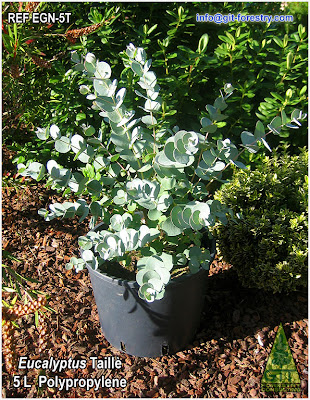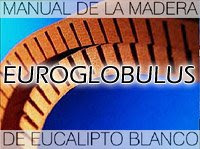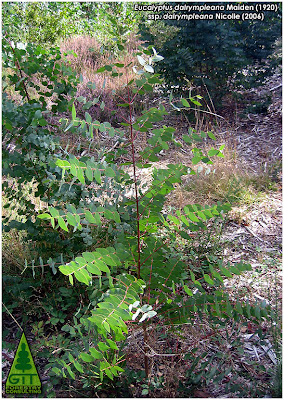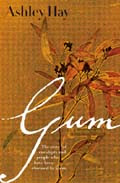Share
 Fig 1: Giant isolated specimen of Eucalyptus globulus growing at sea level near one of the nowadays largest eucalypt forest in Europe.
Fig 1: Giant isolated specimen of Eucalyptus globulus growing at sea level near one of the nowadays largest eucalypt forest in Europe.Impressive growth rates achievable in an all year-round warm climate with abundant rainfall and frequent fog soon caught attention of peasants, foresters and timberjacks. As soon as
1913 some authors quote:
"It is the first species [E. globulus] which has become more common, be it as isolated specimens, be it forming small groves, or sometimes small forests as the so very beautiful one owned by the intelligent agriculturalist and enthusiastic friend of the trees, the Hon. Marquiss of Loureda, from whose timber the good looking telegraph poles recently installed in the Landfill Park of Corunna were provided, as construction timber for the building currently on the works at la Palloza, and many others. This proves, against common belief, it is suitable for different uses"
And also detect issues with its cold hardiness:
"This species, if thriving admirably in our temperate and humid climates, as in our seashores, suffers and even dies in the colder ones, where other already known species should be propagated since they resist very low temperatures, and could become in those forestlands and all the others available with a similar climate, a source of inmense wealth in few years".
Still, in an illetered nation where changes spread mostly "after seeing it worked well for your neighbour" and not by learned readings, planting rates were relatively modest for a long time and concentrated in some particular areas of coastal Galicia. We have recently visited (Fig. 2) one of these areas where cultivation of E. globulus has been continuous for some 70 years.
 Fig. 2: Different stages of Eucalyptus globulus cultivation, showing a mosaic of recently harvested plots, young coppice growth, mature timber crops and new plantings. Agricultural use of land is in regression due to rural exodus and confined to the more fertile lands at the bottom of valleys.
Fig. 2: Different stages of Eucalyptus globulus cultivation, showing a mosaic of recently harvested plots, young coppice growth, mature timber crops and new plantings. Agricultural use of land is in regression due to rural exodus and confined to the more fertile lands at the bottom of valleys.Cultivated mainly in short rotations (12 to 18 years old) and taking advantage on the ability of
E. globulus to resprout from the stump, a
coppice regime is the most usual. Number of alive stumps tends to decrease with time and each subsequent harvest, but it is not uncommon seeing
three or four cycles of timber production before a new planting happens.
It is in many cases this
decreasing number of coppicing stumps by the end of a production cycle and not soil exhaustion what reduces timber outputs in the long term.
 Fig 3: Pictoresque view of a walk through the understorey of the Eucalyptus globulus coastal rainforest in Galicia (Northwestern Spain). Chestnuts, oaks, laurels, fernery...
Fig 3: Pictoresque view of a walk through the understorey of the Eucalyptus globulus coastal rainforest in Galicia (Northwestern Spain). Chestnuts, oaks, laurels, fernery...After more than five decades of continuous cultivation, in this large coastal forest
soils have not been depleted but remain highly productive as long as rational forestry practices have been performed. This fact itself can be quite shocking for those people used to hear that
eucalypts can cause havoc and transform fertile soils into wastelands. But yet another
myth, the one of "
nothing grows under Eucalyptus", can be easily asessed as such just with a short walk through the cultivated forest (Fig. 3). Being walking through a productive timber crop which is subject to periodic operations of harvest and clearing (once per cycle on average), it cannot be expected that a fully functional mature native forest develops. But
the abundance and variety of plants and animals coexisting in these artificial coastal rainforests is certainly far beyond zero.
A humanized landscape, the same way the previous landscape before the arrival of eucalypts was. But sometimes, when wandering through these woods, especially the extramature plantings,
one can easily have the impression of being walking under Australian trees in habitat.
 Fig 4: Seedling of Eucalyptus globulus some weeks after planting
Fig 4: Seedling of Eucalyptus globulus some weeks after plantingIt all started with some few seedlings grown as foreign rarities some 150 years ago. Nowadays
several hundred thousand private investors have voluntarily incorporated Eucalyptus into their timber culture, and the once foreign tree is widely (albeit incorrectly) known as
"Eucalipto do pais" ("Native Eucalypt"). Galicia has become, among other things and with other regions of Northern Spain,
País do Eucalipto.
Eucalyptus country.A friendly final point for those pondering on rumours stating the expansion of
Eucalyptus cultivated forests has been achieved by destroying the almost non existant for the last 200 years ecologically mature native oak forests of Galicia. Think twice and read between the lines. Foresters have been recording "what tree was growing where" from earlier times than those which made these Australian trees achieve an strategic timber resource status. Focusing a bit less on propaganda and a bit more on history might be helpful for all.
Some types of Eucalyptus forests in Galicia and the Northwest of Spain and Portugal
Click to Read Full Story...
Click to Display Summary only...

 (click image to enlarge)
(click image to enlarge) Subscribe to receive EUCALYPTOLOGICS via RSS















































